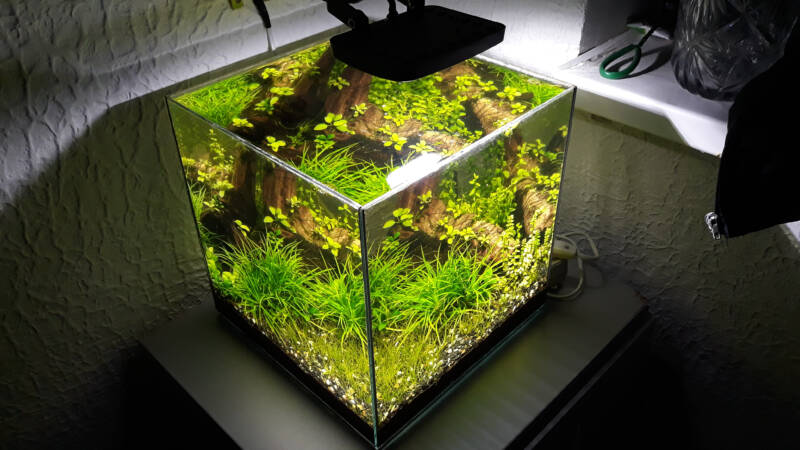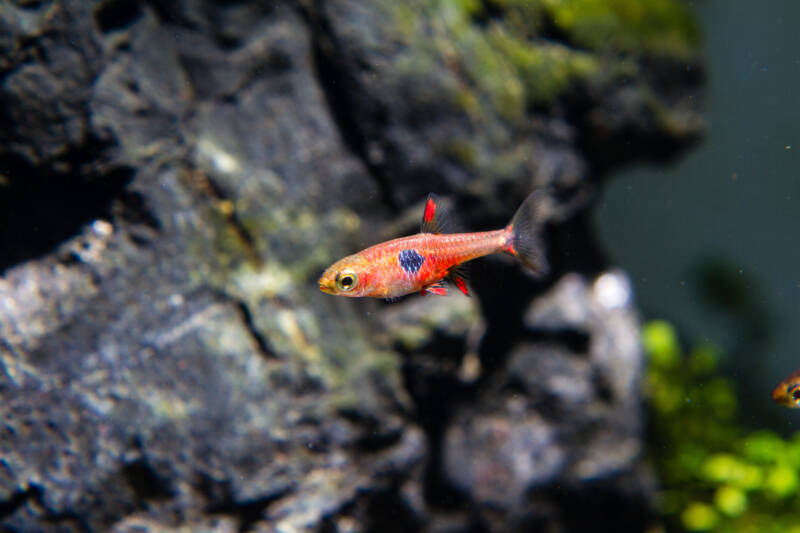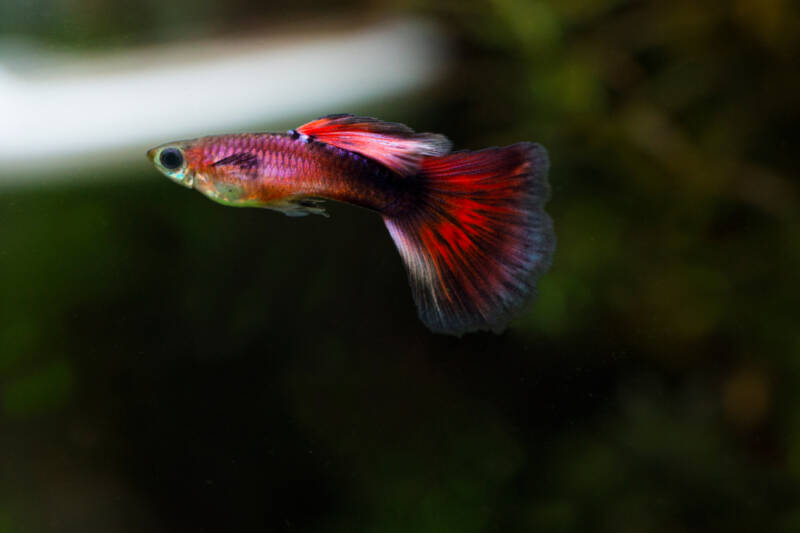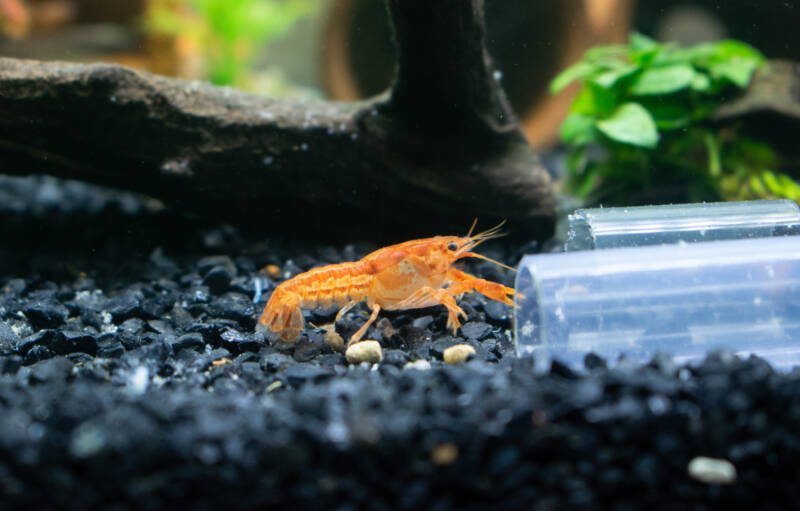Best Fish for a 5-Gallon Tank: A Complete Guide
A 5-gallon tank, often referred to as a nano tank, can be a stunning addition to your home when stocked with the right fish and aquatic plants. While small, these tanks can have a big visual impact with the right setup. However, managing water parameters in such a small tank can be challenging, making it more suitable for aquarists with some experience. Daily water changes and careful monitoring are often necessary to keep your fish healthy.
Below, we’ve compiled a list of the best fish, shrimp, and invertebrates for a 5-gallon freshwater tank. These species are small, low-maintenance, and perfect for nano tanks.

Top Fish for a 5-Gallon Tank
1. Chili Rasbora (Borara brigittae)
- Size: 0.75 inches
- Number: 4-5
- Difficulty: Intermediate
- Temperament: Peaceful
- Diet: Carnivorous (micro-sized flakes, pellets, freeze-dried food)
- Temperature: 68-82°F
Chili Rasboras are tiny, vibrant fish from Indonesia. They thrive in well-planted tanks with open swimming spaces and hiding spots. Keep them in a small school of 4-5 for a 5-gallon tank. Regular water testing and maintenance are essential, as they are sensitive to water conditions.
Shrimp and snails are an excellent choice for a 5 gallon tank, and more beginner friendly.
Before you decide to buy your 5 gallon tank, understand managing the water parameters in such a small tank will be more challenging.
You’ll likely need daily water changes, and is best for people with some aquarium experience as it can be demanding to maintain a tank that size and keep your fish healthy.
All the fish and shrimp listed here are suitable for a 5 gallon tank in the recommended quantity, but will thrive in a 10 gallon tank.
Here are some of my top recommended fish, shrimp, and vertebrates for 5 gallon FRESHWATER tanks.
1. Mosquito/Chili Rasbora (Borara brigittae)

The Chili Rasbora is a bright, delightful fish from South West Borneo, Indonesia. They are some of the smallest fish in tropical freshwater aquariums and are relatively hardy.
These slender, ruby-red fish are best kept in a well-planted aquarium. They like having open water space to swim around and well-planted corners for hiding and resting. Good plants for your Chili Rasbora aquarium are Java fern, Straight Vals (vallisneria spiralis), Ancharis and Java Moss, which are great plants for low-light aquariums.
Keep Chili Rasbora in a school of six, though you can keep a larger school in bigger tanks. They are an active swimming species that likes space, so for a 5 gallon tank keep them as a single-species. They are sensitive to water conditions, so be on top of your tank care with regular water additions and testing. The API Masters Test Kit is our top choice for checking water parameters.
- Number: 4-5
- Size: 0.75 inches
- Difficulty: Intermediate
- Temperament: Peaceful
- Diet: Carnivorous—flakes, pellets, freeze dried food (micro size)
- Temperature: 68-82°F
2. Dwarf Rasbora (Boraras maculatus)

- Size: 0.5-1 inches
- Number: 5
- Difficulty: Beginner-Intermediate
- Temperament: Peaceful
- Diet: Carnivorous (micro-sized flakes, pellets, freeze-dried food)
- Temperature: 75.2-78.8°F
These active, colorful fish are hardy and ideal for beginners. They prefer dark substrates and plenty of plants like Java Moss and Hornwort. Keep them in a small group of 5 for a 5-gallon tank.
3. Strawberry Rasbora (Boraras naevus)

- Size: 0.7 inches
- Number: 6
- Difficulty: Intermediate
- Temperament: Peaceful
- Diet: Omnivorous (micro-sized flakes, pellets, freeze-dried food)
- Temperature: 77-82.4°F
Strawberry Rasboras are peaceful, orange fish that thrive in soft, acidic water. They do well in planted tanks with driftwood and slow-moving water. Keep them in a small shoal of 6 for a 5-gallon tank.
4. Ember Tetra (Hyphessobrycon amandae)

- Size: 0.4-0.8 inches
- Number: 6
- Difficulty: Beginner-Intermediate
- Temperament: Peaceful
- Diet: Carnivorous (micro-sized flakes, pellets, freeze-dried food)
- Temperature: 75.2-82.4°F
Ember Tetras are small, bright orange fish that do well in planted tanks. They prefer softer water and stable conditions. Keep them in a group of 6 for a 5-gallon tank.
5. Celestial Pearl Danio (Danio margaritatus)(Previously Galaxy Rasbora)

- Size: 0.8-1 inches
- Number: 4
- Difficulty: Intermediate
- Temperament: Peaceful (males can be nippy)
- Diet: Omnivorous (prefers live food, but accepts pellets and flakes)
- Temperature: 75.2-78.8°F
These stunning fish have dark blue bodies with yellow spots and orange fins. They thrive in well-planted tanks with moderately hard, alkaline water. Keep them in a small group of 4 for a 5-gallon tank.
6. Guppy (Poecilia reticulata)

- Size: 2-2.5 inches
- Number: 3 males
- Difficulty: Beginner
- Temperament: Peaceful
- Diet: Omnivorous (pellets, flakes, live food)
- Temperature: 68-82°F
Guppies are colorful, easy-to-care-for fish that breed quickly. To avoid overpopulation, keep only males in a 5-gallon tank. They prefer planted tanks with stable pH levels.
7. Endler’s Live Bearer (Poecilia wingei)

- Size: 1.2-2 inches
- Number: 3-4 males
- Difficulty: Beginner
- Temperament: Peaceful
- Diet: Omnivorous (pellets, flakes, live food)
- Temperature: 68-82°F
Endler’s Livebearers are closely related to guppies and are just as easy to care for. They thrive in planted tanks and prefer hard water. Keep only males in a 5-gallon tank to prevent breeding.
8. Scarlet Badis (Dario Dario)
- Size: 0.8-1.2 inches
- Number: 1 male, 1 female
- Difficulty: Intermediate
- Temperament: Semi-aggressive
- Diet: Carnivorous (live or frozen food)
- Temperature: 72-78°F
Scarlet Badis are colorful micro-predators that require live food. They prefer planted tanks with hiding spots and low light. Keep them as a pair in a 5-gallon tank.
9. Forktail Blue-Eye/Furcata Rainbowfish (Pseudomugil furcatus)

- Size: 2-2.4 inches
- Number: 2 females or 2 males
- Difficulty: Intermediate
- Temperament: Peaceful
- Diet: Omnivorous (live/freeze-dried food, pellets, flakes)
- Temperature: 75.2-80.6°F
These active, colorful fish prefer planted tanks with floating plants. Keep 2 individuals of the same sex in a 5-gallon tank.
10. Betta (Betta splendens)

- Size: 2-3 inches
- Number: 1
- Difficulty: Beginner
- Temperament: Peaceful (but aggressive with other bettas and long-finned fish)
- Diet: Carnivorous (live food, pellets, flakes)
- Temperature: 75-82°F
Bettas are ideal for 5-gallon tanks. They thrive in planted tanks with low-flow filtration and prefer to live alone.
11. Dwarf Pea Puffer (Carinotetraodon travancoricus)

- Size: 0.5-1 inches
- Number: 10-25
- Difficulty: Beginner
- Temperament: Peaceful
- Diet: Omnivorous (shrimp pellets, algae wafers, vegetables)
- Temperature: 71.6-82.4°F
Cherry Shrimp are excellent algae eaters and thrive in planted tanks. They are peaceful and can be kept in large numbers in a 5-gallon tank.
12. Least Killifish (Heterandria Formosa)
- Size: 1.5-2 inches
- Number: 5
- Difficulty: Beginner
- Temperament: Peaceful
- Diet: Omnivorous (shrimp pellets, algae wafers, vegetables)
- Temperature: 64-81°F
Amano Shrimp are larger than Cherry Shrimp and are excellent at controlling algae. They do not breed in freshwater, making them a low-maintenance choice.
13. Bluefin Notho (Nothobranchius rachovii)
- Size: 0.5-1.25 inches
- Number: 3
- Difficulty: Beginner
- Temperament: Peaceful
- Diet: Herbivorous (algae, algae wafers, blanched vegetables)
- Temperature: 64.4-82.4°F
Nerite Snails are great algae eaters and won’t overpopulate your tank. They thrive in well-oxygenated water and are perfect for small tanks.
14. Bumblebee Goby (Brachygobius xanthozonus)
 The Bumblebee Goby is a cute, musted-colored fish with dark stripes that is perfect for a small tank. However, despite their appealing looks, they are not easy fish to keep and are best suited to experienced hobbyists.
The Bumblebee Goby is a cute, musted-colored fish with dark stripes that is perfect for a small tank. However, despite their appealing looks, they are not easy fish to keep and are best suited to experienced hobbyists.
Originally from Asia, there is some confusion about whether they are freshwater or brackish fish. Though they can survive in brackish tanks, they prefer freshwater. They prefer tanks with gentle currents decorated with rocks and caves, soft sandy substrate, and added bogwood.
The water should be hard, and the best tank is a single-species tank, as they are prone to aggression. Some people have success keeping them in brackish community tanks, however. They can be territorial, especially if you have too many males in a small tank.
- Number: 1 male or 2 females
- Size: 1.2-1.4 inches
- Difficulty: Advanced
- Temperament: Aggressive
- Diet: Carnivorous—live food, ignore commercial fish foods
- Temperature: 73.4-82.4°F
15. Honey Gourami (Colisa chuna)

Honey Gourami are peaceful fish that do well when kept with a pair of females to every male. They are easy to keep but prefer space and hiding places. The males are an ochre color in the wild, but captive-bred varieties can be more vibrant gold and orange.
You may notice your honey gouramis will go to the surface and gulp. Like Betta fish, they have an organ called a labyrinth, allowing them to breathe air. These dwarf gouramis prefer to hang out in the lower part of the tank.
The tank will need a sound filtration system and slightly acidic water. You can provide the ideal aquarium by planting the tank thickly and allowing a clear middle space. Use floating plants for extra cover and for encouraging bubble nests. Snails make excellent tank companions.
- Number: 1
- Size: 2-2.8 inches
- Difficulty: Beginner
- Temperament: Peaceful, but can be aggressive during breeding
- Diet: Omnivorous—live food, pellet, flake
- Temperature: 72-78°F
16. Asian Stone Catfish (Hara jedoni)
The Asian Stone Catfish is a remarkable small fish from hill streams in Bangladesh and India. It prefers slow-moving water. Provide a sandy substrate and many plants, rocks, and driftwood for cover.
Although it’s a micro-predator, it’s a peaceful little fish that gets on well with other fish the same size. These catfish do best when kept in large groups of their own kind and, ideally, the largest group you can possibly keep, so a big tank is preferable.
They prefer to feed on live or frozen food and may be reluctant to eat pellets or flakes. They are most active and like to feed at night, so provide the tank with bright lighting during the day to ensure a nocturnal mode.
They can be difficult to source and can be a challenging species to keep for beginners. However, once you can get their feeding right and your tank is well-filtered and kept clean, they are an easy species to maintain. They can be kept with adult dwarf shrimp in nano tanks.
- Number: 3-4
- Size: 1-1.2 inches
- Difficulty: Advanced
- Temperament: Peaceful
- Diet: Carnivorous—live food, frozen
- Temperature: 68-75°F
17. Cherry Shrimp (Neocaridina heteropoda)

Cherry Shrimp from Taiwan make excellent inhabitants for small tanks and are often a good choice for keeping with other small fish as they usually stick to the bottom. Females are larger and have a deep red color, while the smaller males are a little more translucent.
Shrimp are also a fantastic way to combat tank algae, as they readily eat algae and other organic matter. These curious little critters prefer tanks that are heavily planted, as they like to be able to hide from predators.
Every month or so, the shrimp will hide away to molt, so don’t be alarmed if your shrimp have mysteriously disappeared. If you’re concerned about keeping fish in a small tank, cherry shrimp are the perfect alternative.
You can keep around 10-25 cherry shrimp in a 5-gallon tank, as they have a very low bioload. When keeping with other fish, a smaller number is better.
- Number: 10-25
- Size: 0.5-1 inches
- Difficulty: Beginner
- Temperament: Peaceful, might be eaten by larger fish
- Diet: Omnivorous—shrimp pellets, algae wafers, vegetables
- Temperature: 71.6-82.4°F
18. Amano Shrimp (Caridina multidentata)

Amano Shrimp are another small freshwater shrimp species from Japan. They do very well in planted aquariums and will consume algae, including some of the more troublesome varieties, which makes them a fantastic addition to almost any tank.
These peaceful little shrimp are bigger than the Cherry Shrimp and translucent green with black spots. Unlike the Cherry Shrimp, they will not breed as they need salt water to reproduce. This can make them a better choice if you worry about overpopulating your tank.
They are easy to keep and compatible with many other fish, and their foraging feeding habits make them excellent at helping keep your tank clean. However, they will be eaten by larger fish. When molting, they hide away until their new shell hardens.
- Number: 5
- Size: 1.5-2 inches
- Difficulty: Beginner
- Temperament: Peaceful, might be eaten by larger fish
- Diet: Omnivorous—shrimp pellets, algae wafers, vegetables
- Temperature: 64-81°F
19. Ghost Shrimp (Palaemonetes paludosus)

Also known as Ivory Shrimp and Glass Shrimp, these see-through freshwater shrimp are easy to keep but should not be housed with other shrimp species. You should also avoid keeping them with large or predatory fish as they will quickly become a snack.
They are larger than Cherry or Amano shrimp and will eat smaller shrimp, fry, and algae. They like to burrow to feed, and they are easier to see if you use a black substrate in your aquarium. Like other shrimp, they will hide away to molt.
Ghost Shrimp are cheap, easy to source, and are peaceful tank inhabitants. They do well kept with snails and fish of a similar size. They are generally hardy and will do well in a small tank, provided the water parameters are maintained and they have plants and other hiding places.
- Number: 3-4
- Size: 2-3 inches
- Difficulty: Beginner
- Temperament: Peaceful, might be eaten by larger fish
- Diet: Omnivorous—shrimp pellets, algae wafers, vegetables
- Temperature: 68-84.2°F
20. Nerite Snail (Neritina natalenis sp)

Nerite Snails are fantastic additions to a small tank. This is are freshwater snails with lovely color variations and do a great job cleaning your tank. its like tanks that are well-oxygenated and have plenty of algae.
They like to eat algae, so they are unlikely to eat your tank plants, and since Nerites need brackish water for the newly hatched snails to survive, they will not over-run your tank. While your Nerite snail may lay eggs, these are unlikely to hatch.
They will spend their time slowly exploring the tank, constantly grazing on algae, so they may starve if your tank has no algae. In this case, you must supplement their diet with algae wafers.
They are sometimes known as Mystery Snails and are popular for being colorful, peaceful, and eating algae. You’ll need a tight lid on your tank to prevent your Nerite Snail from wandering off.
- Number: 3
- Size: 0.5-1.25 inches
- Difficulty: Beginner
- Temperament: Peaceful; avoid keeping with large, aggressive fish
- Diet: Herbivore—algae, algae wafers, blanched vegetables
- Temperature: 64.4-82.4°F
21. Malaysian Trumpet Snail (Melanoides tuberculate)

Malaysian Trumpet Snails are horn-shaped snails that like to burrow into the substrate as like scavenge. This makes them excellent at reducing pockets of anaerobic bacteria that could affect your tank water quality.
They are excellent tank mates for almost any other fish, barring predatory species. They will move slowly about the tank, under the substrate, eating organic debris. The tend to breed rapidly, so keep an eye on them to prevent overpopulation.
Some hobbyists consider them pests as they often hitchhike into tanks via new plants.
- Number: 2
- Size: 0.5-1 inches
- Difficulty: Beginner
- Temperament: Peaceful; avoid keeping with large, aggressive fish
- Diet: Herbivore—pellet food, flake, algae
- Temperature: 64.4-86°F
22. Dwarf Mexican Crayfish (Camberellus patzcuarensis)
 If you’re looking for something slightly more unusual for your tank, consider keeping one of the two species of dwarf crayfish. The Mexican Dwarf Crayfish is a peaceful freshwater lake crayfish and a good addition to community tanks.
If you’re looking for something slightly more unusual for your tank, consider keeping one of the two species of dwarf crayfish. The Mexican Dwarf Crayfish is a peaceful freshwater lake crayfish and a good addition to community tanks.
These crayfish need a tank with hiding places to molt safely and avoid keeping them with predatory fish. A good tank will have caves, logs, driftwood for hiding, and a HOB (hang on back) filter to maintain high water quality.
While wild varieties are brown or olive, new orange variants have been developed, popular with fish keepers.
- Number: 2
- Size: 1.5-2 inches
- Difficulty: Intermediate
- Temperament: Peaceful; avoid keeping with predatory fish
- Diet: Omnivore—live food, scavenger
- Temperature: 71.6-75.2°F
23. Thai Micro Crab (Limnopilos naiyanteri)
 The Thai Micro Crab is a minute freshwater crab species that should be kept in a single-species tank to avoid being eaten. It’s possible to keep it with Micro Rasboras, Ember Tetras, or Cherry Shrimp, but they will like a heavily planted tank with lots of hiding places.
The Thai Micro Crab is a minute freshwater crab species that should be kept in a single-species tank to avoid being eaten. It’s possible to keep it with Micro Rasboras, Ember Tetras, or Cherry Shrimp, but they will like a heavily planted tank with lots of hiding places.
These little light gray crabs are peaceful and shy, and can sometimes be found hiding in the roots of floating plants, so consider adding some hornwort and duckweed. They eat algae and organic debris and prefer neutral to slightly soft, acidic water.
- Number: 5
- Size: 0.3-0.4 inches
- Difficulty: Intermediate
- Temperament: Peaceful; avoid keeping with predatory fish
- Diet: Omnivore—pellets, algae, scavenger
- Temperature: 71.6-75.2°F
FAQ’s
Q: Can I keep a betta fish in a 5-gallon tank?
A: Yes, bettas are well-suited for 5-gallon tanks. Ensure the tank has proper filtration and regular water changes.
Q: How often should I clean a 5-gallon tank?
A: Perform a 25% water change weekly and clean the tank regularly to maintain water quality.
Q: Can I use live plants in a 5-gallon tank?
A: Absolutely! Live plants help oxygenate the water and provide hiding spots for fish. Choose plants that suit your tank’s lighting and size.
Q: What equipment do I need for a 5-gallon tank?
A: You’ll need a filter, heater (if necessary), thermometer, lighting (for live plants), and basic maintenance supplies like a net and gravel vacuum.
Final Thoughts
A 5-gallon tank can be a beautiful and rewarding project when stocked with the right fish and invertebrates. Choose species that are small, peaceful, and low-maintenance to ensure a thriving ecosystem. With proper care and attention, your nano tank can become a stunning centerpiece in your home.
